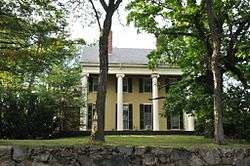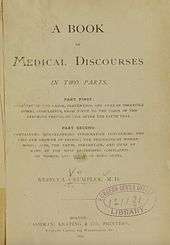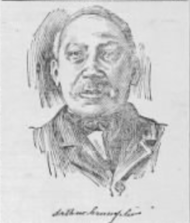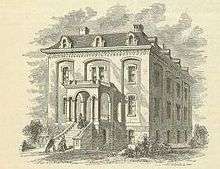Rebecca Lee Crumpler
Rebecca Lee Crumpler, née Davis (February 8, 1831 – March 9, 1895), was an American physician and author. After studying at New England Female Medical College, in 1864 she became the first African-American woman to become a doctor of medicine in the United States.[lower-alpha 1]
Rebecca Lee Crumpler | |
|---|---|
| Born | Rebecca Davis February 8, 1831 |
| Died | March 9, 1895 (aged 64) |
| Nationality | American |
| Alma mater | New England Female Medical College |
| Known for | First female African-American physician |
| Spouse(s) |
|
| Scientific career | |
| Fields | Medicine |
Crumpler graduated medical college at a time when very few African Americans were allowed to attend medical college or publish books. Crumpler first practiced medicine, primarily serving poor women and children in Boston. After the American Civil War ended in 1865, she moved to Richmond, Virginia, believing treating women and children there was an ideal way to perform missionary work. Crumpler worked for the Freedmen's Bureau to provide medical care to freed slaves. She was subject to "intense racism" and sexism while practicing medicine.
She later moved back to Boston to continue to treat women and children. In 1883, she published A Book of Medical Discourses. Dedicated to nurses and mothers, it focused on maternal and pediatric medical care and was one of the first publications written by an African American about medicine. Crumpler was in fact the only female physician author in the 19th century. A pre-health club named The Rebecca Lee Pre-Health Society at Syracuse University and the Rebecca Lee Society, one of the first medical societies for African-American women, were named after her. Her Joy Street house is a stop on the Boston Women's Heritage Trail.
Early life and education
In 1831, Crumpler was born Rebecca Davis in Christiana, Delaware to Matilda Webber and Absolum Davis.[4][5] She was raised in Pennsylvania by an aunt who cared for infirm neighbors.[1][2] Her aunt acted as the doctor in her community and had a huge influence on her.[5] She moved to Charlestown, Massachusetts, in 1852.[6]
Career
Nursing and medical school
From 1855 to 1864, Crumpler was employed as a nurse.[4][lower-alpha 2] She was accepted into the New England Female Medical College in 1860. This school was founded by Drs. Israel Tisdale and Samuel Gregory.[1][2][6] She won a tuition award from the Wade Scholarship Fund, which was established by the Ohio abolitionist, Benjamin Wade.[7]
It was rare for women or black men to be admitted to medical schools during this time. In 1860, due to the heavy demands of medical care for Civil War veterans,[8] there were more opportunities for women physicians and doctors. Due to her talent, Crumpler was given a recommendation to attend the school by her supervising physician when she was a medical apprentice.[2][4] That year, there were 54,543 physicians in the United States, 300 of whom were women. None of them were African Americans.[6][lower-alpha 3]
Crumpler graduated from New England Female Medical College in 1864[10][lower-alpha 4] after having completed three years of coursework, a thesis, and final oral examinations in February 1864. On March 1, 1864, the board of trustees named her a Doctor of Medicine.[2] Married to Wyatt Lee at that time, she was identified as Mrs. Rebecca Lee by the school,[6][9] where she was the only African American graduate. She was the country's first African-American woman to become a formally-trained physician.[1][lower-alpha 5]
Physician
Crumpler first practiced medicine in Boston. She primarily cared for poor African-American women and children.[2] After the end of the American Civil War (1861–1865), she moved to Richmond, Virginia, believing it to be an ideal way to provide missionary service, as well as gain more experience learning about diseases that affected women and children. She said of that time, "During my stay there nearly every hour was improved in that sphere of labor. The last quarter of the year 1866, I was enabled... to have access each day to a very large number of the indigent, and others of different classes, in a population of over 30,000 colored." Crumpler worked for the Freedmen's Bureau to provide medical care to freed slaves who were denied care by white physicians.[11] At the Freedmen's Bureau she worked under the Assistant Commissioner, Orlando Brown.[6] Subject to intense racism by both the administration and other physicians,[11] she had difficulty getting prescriptions filled and was ignored by male physicians.[11] Some people heckled that the M.D. behind her name stood for "Mule Driver".[1][2][lower-alpha 6]
Crumpler moved to 67 Joy Street in Boston,[12] a predominantly African-American community street in Beacon Hill. She practiced medicine and treated children without much concern for the parents' ability to pay.[1] (Her house is on the Boston Women's Heritage Trail.[12])
Educator

In the early 1870s, Crumpler attended the elite West Newton English and Classical School in Massachusetts,[4][13] where she was a "special student in mathematics."[4] Crumpler taught in Wilmington beginning in 1874 and in New Castle, Delaware beginning in 1876.[4]
A Book of Medical Discourses
In 1883, Crumpler published A Book of Medical Discourses from the notes she kept over the course of her medical career. Dedicated to nurses and mothers,[1][2] it focused on the medical care of women and children.[14] Her main desire in presenting this book was to emphasize the "possibilities of prevention." [15] Therefore, she recommended that women should study the mechanisms of human structure before becoming a nurse in order to better enable themselves to protect life. However, Crumpler stated that most nurses did not agree with this and tended to forget that for every ailment, there was a cause and it was within their power to remove it.[15] Though her primary focus was on the health of women and children, which seemed to be influenced by homeopathy, Crumpler recommended courses of treatment without stating that the treatment was homeopathic. She did not mention that medicine could be harmful, but stated the conventional amount of standard medicine usage.[10] Her medical book is divided into two sections: in the first part she focuses on preventing and mitigating intestinal problems that can occur around the teething period until the child is about five years of age;[6] the second part mainly focused on the following areas: "life and growth of beings", the beginning of womanhood and the prevention and cure of most of the "distressing complaints" of both sexes.[16]Although the book was focussed on medical advice, Crumpler also ties in autobiographical details that contain political, social, and moral commentary.[17] Specifically in the first chapter, Crumpler gave non-medical advice concerning her thoughts on what age and how a woman should enter into marriage. The chapter also contained advice for both men and women on how to ensure a happy marriage. [18] Crumpler describes the progression of experiences that led her to study and practice medicine in her book:

It may be well to state here that, having been reared by a kind aunt in Pennsylvania, whose usefulness with the sick was continually sought, I early conceived a liking for, and sought every opportunity to relieve the sufferings of others. Later in life I devoted my time, when best I could, to nursing as a business, serving under different doctors for a period of eight years; most of the time at my adopted home in Charlestown, Middlesex County, Massachusetts. From these doctors I received letters commending me to the faculty of the New England Female Medical College, whence, four years afterward, I received the degree of Doctress of Medicine.[19][20]
At the time, writings and books by African-American authors had prefaces and introductions written in the style of white male writings to give them authentication. Crumpler was able to introduce her own text, and was also able to justify her work based on her own authority.[17]
Personal life
While living in Charlestown, Rebecca Davis married Wyatt Lee, a Virginia native and former slave. They were married on April 19, 1852,[6][21]. This was Wyatt’s second and her first marriage.[22] A year later Wyatt’s son, Albert, died at age 7.[23] This tragedy may have motivated Rebecca to begin her study of nursing for the next 8 years. Rebecca was still a medical student when her husband died of tuberculosis on April 18, 1863. He is buried at Mount Hope Cemetery in Boston.[24]

Dr. Rebecca Lee married Arthur Crumpler in Saint John, New Brunswick on May 24, 1865.[25][26] Arthur was a former fugitive slave from Southampton County, Virginia. Born in 1824, he was the son of Samuel Crumpler, a slave of Benjamin Crumpler. Arthur lived on the neighboring estate of a large landowner, Robert Adams, with his mother and siblings. When Adams died, his family was sold and nine-year-old Arthur was kept by Robert Adams' son, John Adams of Smithfield, Virginia after Arthur won a wrestling contest with John on the day of the estate auction. Except for one sister, he never found out the whereabouts of the people who purchased his family members. He served with the Union Army at Fort Monroe, Virginia as a blacksmith, based upon his training and experience. He went to Massachusetts in 1862 and was taken in by Nathaniel Allen, founder of the West Newton English and Classical School, called the Allen School.[27][28] On July 16, 2020, a ceremony was held at the Fairview Cemetery to dedicate a gravestone in memory of Rebecca Lee Crumpler and her husband Arthur. The granite stone was the result of a fundraising appeal spearheaded by Vicky Gall, a history buff and president of the Friends of the Hyde Park Library. [29]
The couple were active members of the Twelfth Baptist Church where Arthur was a trustee.[27] They had a home at 20 Garden Street in Boston.[27] Their daughter Lizzie Sinclair Crumpler was born in mid-December 1870.[30]
Crumpler spoke at a service for Massachusetts Senator Charles Sumner upon his death in 1874. She read a poem that she had written for him, where "she touchingly alluded to his love for the gifted Emerson".[31] By 1880, the Crumplers moved to Hyde Park, Boston.[27]
Although no photographs or other images of Crumpler survive,[1] a Boston Globe article described her as "a very pleasant and intellectual woman and an indefatigable church worker. Dr. Crumpler is 59 or 60 years of age, tall and straight, with light brown skin and gray hair."[32] About marriage, she said the secret to a successful marriage "is to continue in the careful routine of the courting days, till it becomes well understood between the two".[27]
Rebecca Crumpler died on March 9, 1895, in Fairview, Massachusetts, while still residing in Hyde Park.[27] She and her husband Arthur are both buried at the nearby Fairview Cemetery.[33] Arthur died in May 1910.[34] On July 16, 2020, a ceremony was held at Fairview Cemetery, as a gravestone was finally installed, marking where she and her husband are buried. [35]
Legacy
The Rebecca Lee Society, one of the first medical societies for African-American women, was named in her honor.[2] Her home on Joy Street is a stop on the Boston Women's Heritage Trail.[36]
At Syracuse University there is a pre-health club named "The Rebecca Lee Pre-Health Society". This club encourages people of diverse backgrounds to pursue health professions. They offer mentors, workshops, and resources to help members succeed.[37]
See also
Further reading
- "Female Medical College of 100 Years Ago Had Two Professors and Not Even a Skeleton", O'Brien, Mary; Daily Boston Globe (1928–1960); October 21, 1948; p. 20.
Notes
- Rebecca Cole was previously identified as the first African-American female physician. Subsequent research shows Crumpler was first (1864),[1] Cole second (1867) and Susan McKinney Steward third.[2][3]
- Formal training was not required until nursing schools were established, which did not occur until 1873.[1]
- The faculty was hesitant to pass Crumpler because they thought she showed slow progress in learning. They ended up passing her. The doctors whom Crumpler worked with while in medical school helped persuade the faculty to pass her.[9]
- Claims have been made that she was "homeopathically trained", and gained a lot of knowledge from other pioneers in her field at the medical college.[10] However, Crumpler and the many other pioneers are not recognized, nor does "history record them as homeopathic practitioners."[10]
- The school closed in 1873 due to financial issues,[10] without graduating another black woman.[1][2]
- The great need for medical providers encouraged other black people to join the medical profession. Black charitable organizations and white missionary organizations provided funding for the first black medical schools.[2]
References
- "Dr. Rebecca Lee Crumpler Biography". Changing the Face of Medicine. National Library of Medicine. Retrieved May 2, 2013.
- Henry Louis Gates; Evelyn Brooks Higginbotham (March 23, 2004). African American Lives. Oxford University Press. pp. 199–200. ISBN 978-0-19-988286-1. Retrieved May 2, 2013.
- Vernon L. Farmer; Evelyn Shepherd Wynn (2012). Voices of Historical and Contemporary Black American Pioneers. ABC-CLIO. pp. 11–12. ISBN 978-0-313-39224-5. Retrieved May 3, 2013.
- Fay, Eugene Francis (1895). An illustrated biographical catalogue of the principals, teachers, and students of the West Newton English and Classical school, West Newton, Mass., l854-l893 : including an account of the re-unions November 15, 1871, and June 21, 1893. Boston: R. Avery Supply Co. p. 23.
- "Dr. Rebecca Lee Crumpler". Changing the Face of Medicine. U.S. National Library of Medicine. Retrieved January 29, 2017.
- Dr. Howard Markel (April 7, 2016). "Celebrating Rebecca (Davis)Lee Crumpler, first African-American woman physician". PBS. Retrieved February 22, 2017.
- "The Historical Contributions of African Americans to the Advancement of Health and Science". Congressional Record Vol. 146-Part 2: Proceedings and Debates of the 106th Congress Second Session. Government Printing Office. 2000. p. 2107. GGKEY: HL8BK2RDHWR.
- "Rebecca Lee Crumpler becomes First Black Woman to Receive M.D. Degree". The Chicago Citizen, Chatham-Southeast edition: 3. February 24, 2014.
- Pfatteicher, Sarah K. A. (2000). "Crumpler, Rebecca Davis Lee (1831–1895), physician". American National Biography. doi:10.1093/anb/9780198606697.article.1201058.
- Davidson, Jonathan. (2014). "Women, Reform, and Medical Leadership". A Century of Homeopaths: 9. doi:10.1007/978-1-4939-0527-0_3. ISBN 978-1-4939-0526-3.
- McCloud, Melody T. (March 3, 2016). "Women's History Month Honors Rebecca Lee Crumpler, M.D. First Black Female Physician in the United States". Psych Central.com.
- "Beacon Hill". Boston Women's Heritage Trail. Retrieved April 10, 2020.
- "Newton, MA - Allen Family". Historic Newton - Newton, Massachusetts government. Retrieved February 19, 2020.
- Darlene Clark Heine; Kathleen Thompson (October 14, 2009). A Shining Thread of Hope. Crown/Archetype. p. 162. ISBN 978-0307568229. Retrieved April 17, 2015.
- Crumpler, Rebecca Lee (1883). A Book of Medical Discourses -In Two Parts. Boston: Cashman, Keating, & Co. pp. 3–4.
- Crumpler, Rebecca Lee (1883). A Book of Medical Discourses - In Two Parts. Boston: Cashman, Keating, & Co.
- Allen, Patrick S. (2018). "We must attach the system: The Print Practice of Black 'Doctresses'". Arizona Quarterly: A Journal of American Literature, Culture, and Theory. 74 (4): 87–113. doi:10.1353/arq.2018.0023.
- Crumpler, Rebecca Lee (1883). A Book of Medical Discourses - In Two Parts. Boston: Cashman, Keating, & Co. pp. 5–6.
- Gregory, MD, Samuel (1868). Doctor or Doctress?. Boston: Trustees of New England Female Medical College. p. 8.
- Crumpler, MD, Rebecca (1883). A Book of Medical Discourses: In Two Parts. Boston: Cashman & Keating CO. p. 158.
- Wyatt Lee and Rebecca Davis marriage, Massachusetts, Marriage Records, 1840-1915. Massachusetts Vital and Town Records., April 19, 1852
- Marriage Intentions, 1849-1858; Vol. 3. Massachusetts, Town and Vital Records, 1620-1988
- Albert Lee, Massachusetts, Death Records, 1841-1915
- "Wyatt Lee, registered April 18, 1863, death April 17, 1863", Deaths in Boston, Town and City Clerks of Massachusetts. Massachusetts Vital and Town Records., 1863
- "Marriage announcements". The Religious Intelligencer. Saint John, New Brunswick. June 2, 1865.
- Caroline Rance (December 15, 2015). The History of Medicine in 100 Facts. Amberley Publishing Limited. p. PT139. ISBN 978-1-4456-5004-3.
- Anthony W. Neal (September 5, 2012). "Dr. Crumpler: Nation's first African American woman physician". The Bay State Banner. Retrieved February 22, 2017.
- "Boston's Oldest Pupil: He's 74, and He Goes to the Evening School". The Boston Sunday Globe. April 3, 1898. p. 25 – via newspapers.com (clipping).
- Brian MacQuarrie, "Gravestone dedicated to the first Black female medical doctor in the US." Boston Globe, July 18, 2020.
- Massachusetts, Birth Records, 1840-1915, [Lizzie Sinclair Crumpler, December 1870, Boston, Massachusetts, Arthur and Rebecca Crumpler]
- "The Colored People's Memorial". The News Journal. Wilmington, Delaware. March 17, 1874. p. 1 – via newspapers.com (clipping).
- Bolden, Tonya (March 3, 2020). Changing the Equation: 50+ US Black Women in STEM. Abrams. pp. PT18. ISBN 978-1-68335-629-5.
- Adele Logan Alexander (December 18, 2007). Homelands and Waterways: The American Journey of the Bond Family, 1846-1926. Knopf Doubleday Publishing Group. p. 286. ISBN 978-0-307-42625-3.
- "Ex-slave laid to rest". The Boston Globe. May 11, 1910. p. 4. Retrieved February 20, 2020.
- Brian MacQuarrie, "Gravestone Dedicated to the First Black Female Medical Doctor in the US." Boston Globe, July 18, 2020, p. B1.
- "Beacon Hill". Boston Women's Heritage Trail.
- "Rebecca Lee Pre-Health Society". orgsync.com. Archived from the original on November 14, 2018. Retrieved April 28, 2018.
External links
- Rebecca Lee Crumpler, First African American Woman Doctor
- Works by or about Rebecca Lee Crumpler at Internet Archive
